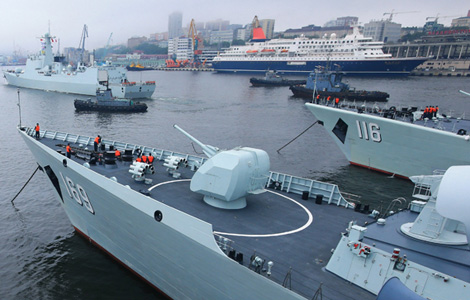China, Russia begin live-fire navy drill
Updated: 2013-07-09 00:29
By ZHAO SHENGNAN and PU ZHENDONG in Vladivostok, Russia (China Daily)
|
||||||||
Range of exercises shows trust between China and Russia
Chinese and Russian naval forces left Vladivostok on Monday and arrived in the Sea of Japan, where they began the live-fire phase of a joint naval drill called "Joint Sea 2013", the largest-ever Sino-Russian exercise of its kind.
Officials and observers say the range of tasks and the involvement of Russian and Chinese personnel in each scenario demonstrate mutual trust between the two forces and a determination to jointly address maritime threats while safeguarding regional stability.
 |
|
Chinese and Russian sailors participate in the live-fire phase of the "Joint Sea 2013" naval drill in Vladivostok, Russia, on Monday. [Photo/Xinhua] |
Amid the mist on Monday afternoon, four destroyers and two frigates from China sailed out of Vladivostok, along with the Russian Pacific Fleet's flagship cruiser the Varyag, on course for their rallying point in Peter the Great Gulf. One Chinese supply ship and other 11 warships from Russia, including the destroyer Admiral Vinogradov and a Kilo-class submarine, set sail for the same destination.
The Chinese fleet, the largest China has ever sent abroad for a joint drill, arrived in Vladivostok July 5, and will conclude its operations on Friday after a fleet review.
The Chinese task force is under the command of Ding Yiping, deputy commander of the naval forces of the Chinese People's Liberation Army.
"Scenario-based drills such as this are a valuable opportunity for practice," Ding said during a brief ceremony on Monday morning.
He said that commanding the current exercise is difficult due to the large number of staff involved, as well as complex weather conditions and the large amount of ammunition used.
Eleven types of military tasks will be tackled over the next few days, including anti-submarine and anti-ship operations, maritime air defense, escort drills and marine search and rescue operations, according to Ding.
Yin Zhuo, director of the Navy Information Expert Committee of the PLA, said the anti-submarine exercise highlights the two navies' deepening mutual trust, because information about a country's submarines is rarely shared.
More importantly, the two navies are working closely together to direct the exercise, both on shore and at sea.
Zhao Yi from the North Sea Fleet is one of the three Chinese officers onboard Russia's cruiser the Varyag while at sea. He said he was confident he could accomplish his various missions in cooperation with his Russian counterpart, despite the language obstacles.
"We've made solid preparations during the table maneuvers, and interpreters from both sides are on board just in case of any emergency," he said. Six Russian officers will also work on two of the four participating Chinese destroyers.
Wang Ling, a senior officer with the Chinese task force said that cooperation between the two navies has been increasingly smooth, although unexpected "emergency" situations during exercises, such as mechanical problems, can help to strengthen problem-solving capabilities.
Mist and rain may interrupt the drill, said Chen Lu, a sailor working on the Chinese destroyer Lanzhou. "But it would not be a problem for me, ... As a member of the navy, I need to maintain combat readiness at all times," he said.

 China's youngest city glistens under palm trees
China's youngest city glistens under palm trees
 Xinjiang tourism recovering
Xinjiang tourism recovering
 Quebec disaster death toll jumps to 13
Quebec disaster death toll jumps to 13
 Mourn for students in San Francisco air crash
Mourn for students in San Francisco air crash
 Rolling stone finally settles
Rolling stone finally settles
 Double-decker bus caught fire in Shanghai
Double-decker bus caught fire in Shanghai
 China, Russia begin live-fire navy drill
China, Russia begin live-fire navy drill
 Grape expectations for Xinjiang county
Grape expectations for Xinjiang county
Most Viewed
Editor's Picks

|

|

|

|

|

|
Today's Top News
Air crash victims' families arrive in SF
Hopes are high for US, China talks
Laden's life on the run revealed
US mulls hastening withdrawal from Afghanistan
China's inflation grows 2.7% in June
Country singer Randy Travis in critical condition
Police look for suspects in Brazil soccer slaying
Nuclear power pricing system launched
US Weekly

|

|






